Transforming the e-Mobility Urban Landscape in India


I congratulate GreenTree Global for putting together this 4thedition of the GREENLetter on the topic ‘Transforming the e-Mobility Urban Landscape in India’. It gives me immense pleasure to be contributing to the sustainable agenda that GreenTree Global team is propounding. It is an urgent need for the planet we live in and could be essential for mankind’s survival. With the rapid urbanisation and population migration towards urban centres, local environmental issues such as pollution need to be addressed. This affects health, quality of life and accessibility. Urban transport, which has traditionally been based on fossil fuel has been one of the primary causes for deteriorating air quality in cities. A significant effort worldwide is taking shape, especially with an impending COP26, to decarbonise the transport systems by promoting zero-emission vehicles and use of clean or renewable energy. Governments around the world have announced pledges towards gradual phasing out of fossil fuel based vehicles in favour of zero-emission vehicles.
In this newsletter we have also covered GTG’s assessment of green building market development in Quarter 4 FY20-21. Government initiatives, schemes and sustainable infrastructural development associated with the evolving zero emission electric-mobility industry in India have been highlighted in detail. Social issues such as gender equality and social inclusion have also been contextualised, which is pertinent as climate change impact on the vulnerable segments is relatively more severe. Views of Mr. N Mohan from EESL provides insight into EESL’s first ever public procurement business model of EV charging stations for Delhi.
For a developing nation like India, decarbonisation of transport has far reaching benefits beyond merely air quality, lifestyles and making urban centres more attractive. It could create a completely new industrial value chain, generating employment and innovation at scale, akin to what India has done with mobile phones and solar energy. Indian innovations and indigenous solutions can also set the stage for other developing countries around the world. This is indeed an ambitious agenda.
There is quite a bit of focus on electrification of 2-wheelers, 3-wheelers, cars and small vans. While the conversion of existing fleet into electric ones will surely bring benefits to urban environment, if the urban space is to be used judiciously, a good quality and decarbonised public transport is a must. Electric buses are a viable and in most cases present an economical solution. Government’s FAME II provides an impetus to the uptake of electric buses but it requires more effort at the city or state level. Commercial vehicles present a different kind of challenge. They are the biggest contributors to pollution in cities due to heavy usage and larger environmental footprint. Hydrogen fuel based trials are ongoing in many cities around the world and India should also put research and development resources in providing economical solutions.
A lot can be written on this beyond what is contained in this newsletter. What is important for us is to understand that “business as usual” is no longer viable. If we are to ensure a healthy planet for future generations, we must act today or even now. Enjoy the newsletter and be a part of a green journey. Thank you!

21 cities out of 30 cities in India are strongly affected by the air pollution and continuity can cause permanent harm to the health of citizens, including abnormal changes in new born babies (WHO, 2017). Industrial emissions, construction, and vehicular pollution directly into the environment are the main causes of the development of air pollution in cities. These emissions consist of air pollutants such as carbon monoxide, Nitrogen dioxide, Sulphur dioxide, Lead, and dust that can trigger the formation of cancerous cells in a human body and death of premature babies. The particulate matters of PM2.5 and PM10 are not easy to be filtered through the normal process of filtration hence the only solution to this is through alternative sources of energy to drive machines and vehicles. Since mobility is part of a person's everyday life, developing and implementing policies is extremely necessary for EVs.
Recent interventions in the area of green transformation have opened a new door to electric mobility, such as the expansion of clean energy, the battery packs, technical advancement and industrial production of vehicles and various components. Thus, the emergence of a vehicle of consciousness that is easily adaptable, environmentally friendly and bridging the gap for gender inequality is not far off. Let us provide you with an overview of the benefits of electric cars.
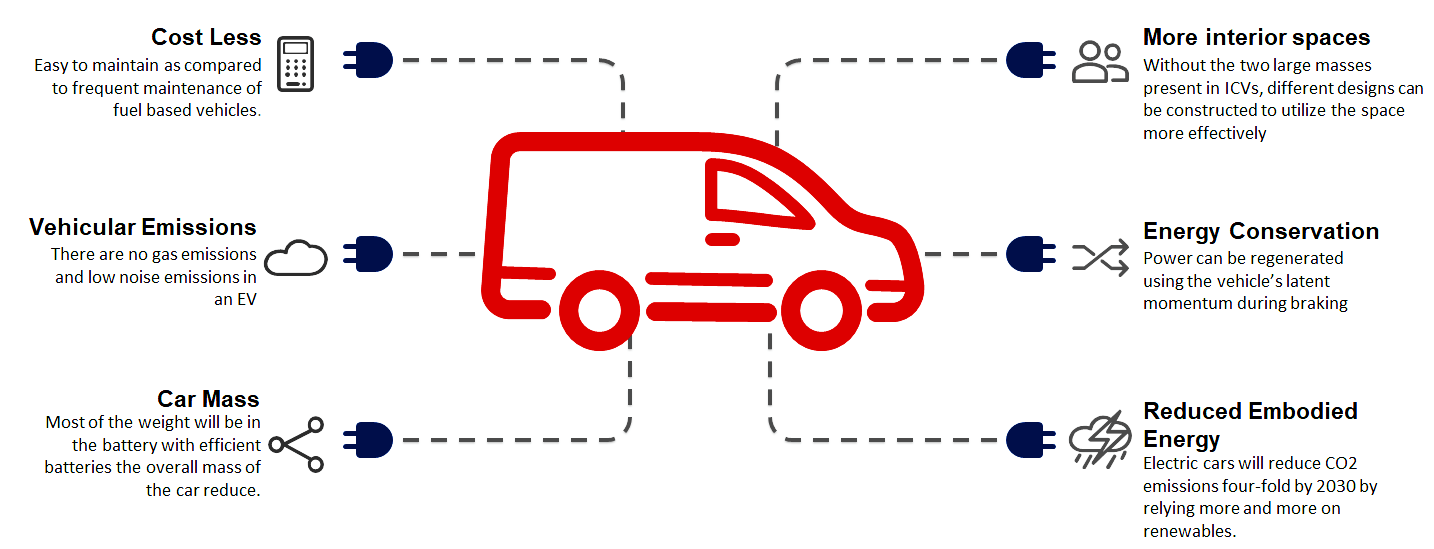
The study titled 'Green Vehicle Rating: Reshaping Consumer Knowledge on Environmental Performance of Vehicles' shows that the lack of adequate information in the public domain and the difficulty in understanding emissions data, are the pressing reasons why the purchase of fuel-based vehicles continues to take place. Making a change in consumer behaviour starts at the Centre with policy support, subsidies and incentives for EV ownership. The impact of the main pollutants and CO2 emissions on health and the environment must be underlined and advocated at a grand scale. Bearing this in mind, the Alliance for an Energy Efficient Economy (AEEE) and the Shakti Foundation have developed the Green Vehicle Rating (GVR) System for 2- and 3-wheel vehicles. The rating system evaluates the following 5 steps - Link of the detailed report
In accordance with the GVR methodology, the vehicle rating was created, where damage from an individual vehicle is standardised to a reference vehicle, followed by discrete results such as:
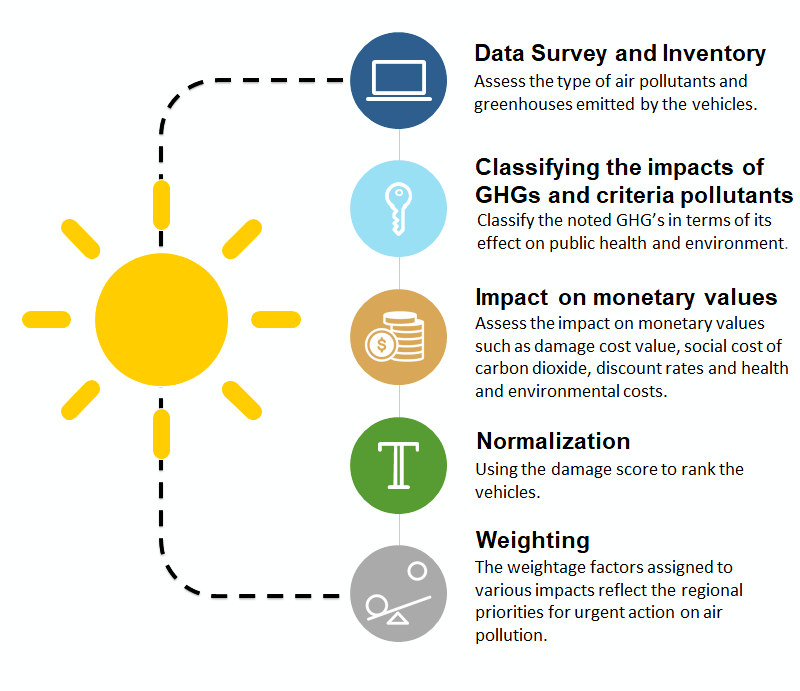
In accordance with the GVR methodology, the vehicle rating was created, where damage from an individual vehicle is standardized to a reference vehicle, followed by discrete results such as:
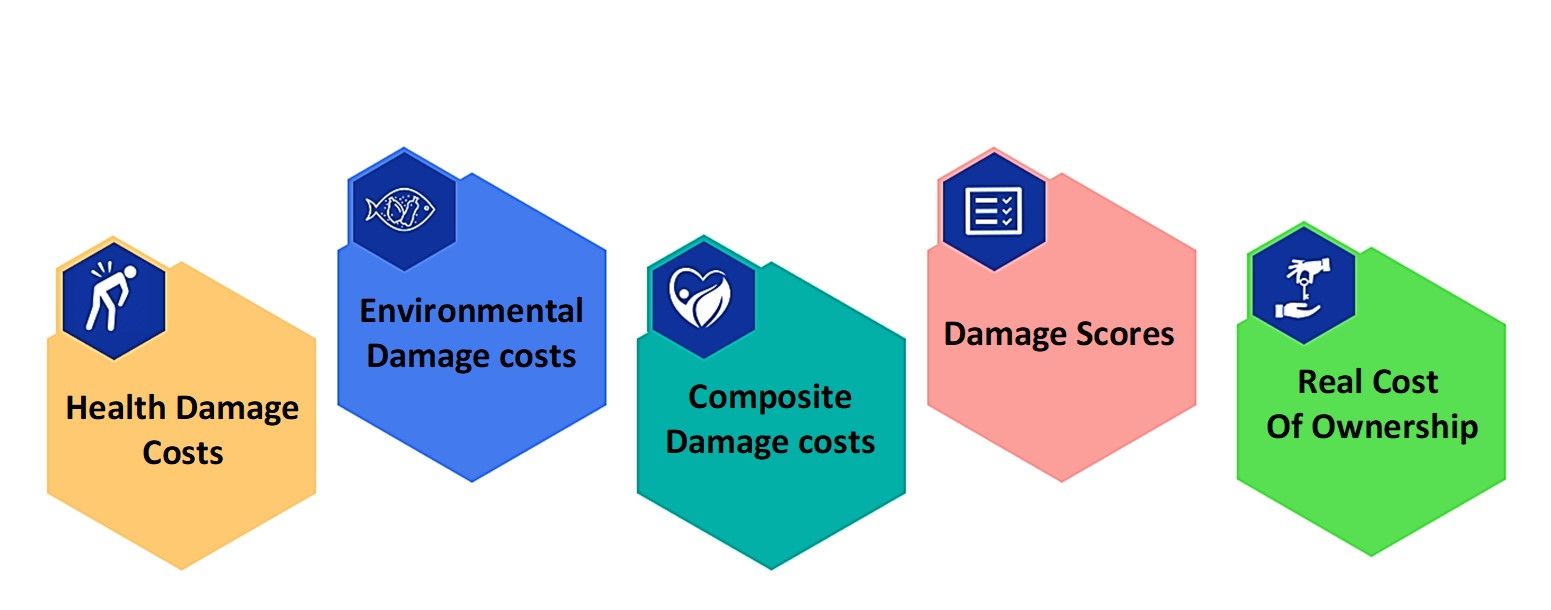
Taking charge to compare the pollution generated by a fuel-based vehicle against the health cost of the causes it creates is a great framework. Yet, the five steps defined may not completely encourage people to adopt electric vehicles. The ease of implementation of e-mobility plans for 4- wheelers are easier compared to the two wheelers. This owes to the large difference in investment a road user ends up putting in at the end of the day. As per the typical Indian mind set, one would rather prefer to utilise the fuel based vehicle for approximately 20km in comparison to the EVs, with the notion that the EVs can't be used for the longer distance. This emerges from various factors such as inadequate charging station set up in dense regions, range anxiety, lack of road user assistance, etc.
The adoption can only be encouraged through strict guidelines, public awareness and through influential incentives.
Green Building Market in India
The green buildings market in India is registering a positive growth with every passing quarter. Environmental consciousness among consumers does not remain restricted to only buildings now, it has spread across other sectors like transportation and integrated cities, as well.
It is a common misconception concerning 'green' projects that climate-friendly projects are high-end and are associated with luxury costs. As consulting organisations in this space, we have come across various technological interventions which offset high costs and create an impactful and positive effect on the overall development of living spaces. Read our blog on MRG World: How affordable can become sustainable- A good example in Gurgaon Real Estate and gain insight into the green measures implemented in the project!
The demand for green bonds and sustainable bonds has picked up in India recently, almost double the amount of 2020, with GMC (Ghaziabad Municipal Corporation) securing nearly Rs. 150 crore for a tertiary sewage treatment plant! Another good news is that India is #5 on the Global Green Building Survey in the category of highest number of green LEED-rated projects. This is a promising figure and gives the real estate industry an encouraging push in the right direction.
We have conducted an in-depth market progress study for the last quarter Q4 for the financial year 2020-2021. The team sourced data from various green building rating agencies.
For integrative analysis, the levels in various rating systems are merged into common performance level, i.e. Outstanding, Excellent, Marked, Competent Performance as per the data received from GBCI, IGBC & GRIHA and data collected through desk research.
GBCI LEED has registered a healthy number of green building projects (Registered Projects: 25, Rated Projects: 59) in the Quarter 4: 2020-2021 (Source: Public LEED Directory). Unlike past quarters' trends, Delhi has performed exceptionally well this quarter and maintained competition with green states like Maharashtra and Karnataka. Recently, ITC Windsor emerged as the world’s first hotel to achieve LEED Zero Carbon Certification. This move will bring much change to the way we view responsible and sustainable luxury!
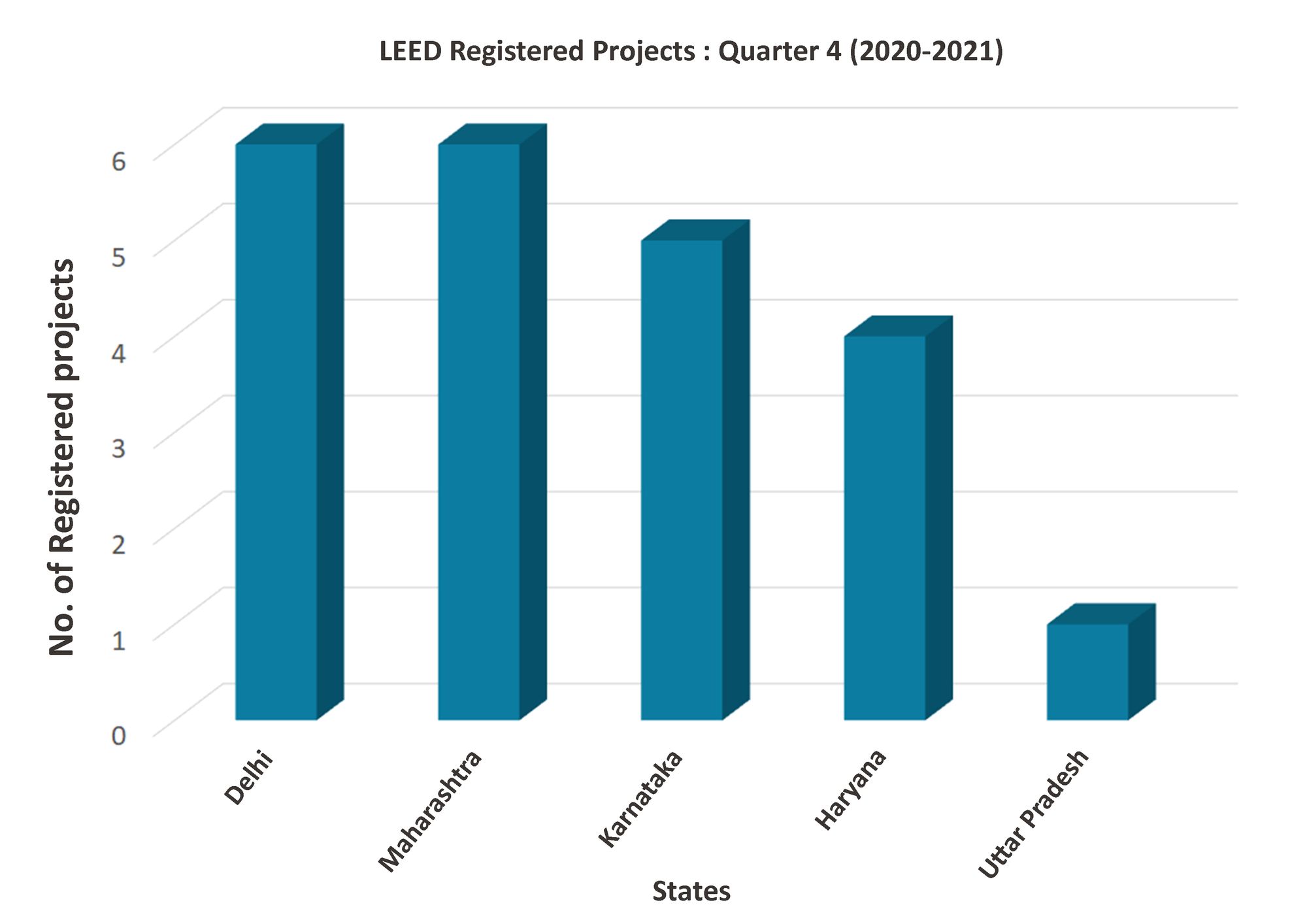


IGBC continues to make a space for itself in Maharashtra with the highest number of projects certified in Quarter 4: 2020-2021 (Source: IGBC). Its close competitors Karnataka and Tamil Nadu also boast of a good number, indicating a rise in competition and marketability of sustainability as a viable option in real estate!
GRIHA too has carved a space out for itself, by registering the highest number of projects from Maharashtra, 18 in number, in Quarter 4: 2020-2021 (Source: GRIHA). As is evident with GRIHA rated government projects, the State and Central projects are establishing great benchmarks of sustainability for a positive impact on the green buildings industry. Haryana emerges as the state with the highest number of GRIHA rated projects in the quarter, followed by Karnataka and Tamil Nadu.


The State of Andhra Pradesh
The Ease of Living Index 2020 report published by the Ministry of Housing and Urban Affairs ranks cities on the basis of liveability, sustainability, affordability, and economic development. Visakhapatnam (ranked: 15) and Vijayawada (ranked: 41) are among the 49 most liveable cities in India in the Million+ population category.
In a first, Andhra Pradesh is also mulling over setting up an Energy Conservation Cell (ECC) in all government departments to promote efficient use of energy and considerations over energy security, economic development and climate change mitigation. 87 ECCs have been identified to be deployed in each government department. This fantastic move will encourage even private players in the state to adopt such facility goals in their capacities.
Provided below is a graphical representation of the green rated buildings which have aggregated in the state, based on the data provided to us by LEED, IGBC and GRIHA.
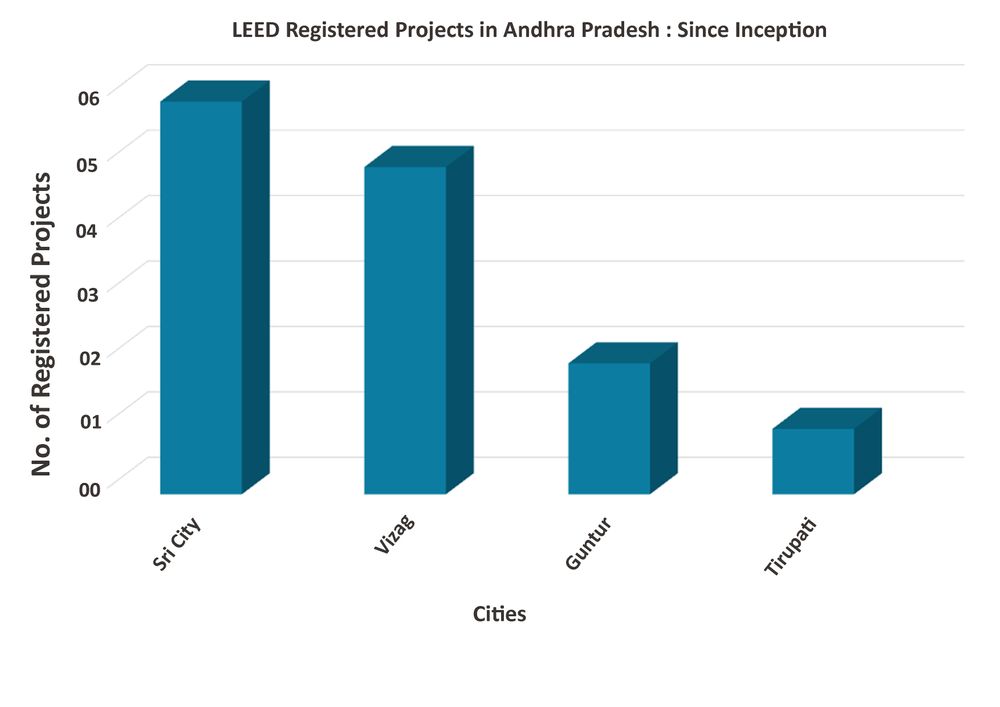
LEED has registered 14 green projects in Andhra Pradesh (LEED Public Directory: Registered project: Since Inception). What stands out with prominence in the graph is the mention of Sri City. It was conferred with the “Most Sustainable Integrated Business City” award by Times Network in 2017.
What makes a business city 'sustainable'?
- Incentivised sustainable urban planning or development of sustainable urban ecosystem
- Safe, inclusive and accessible, green and public spaces
- Enhanced capacity for participatory, integrated and sustainable human settlement
- Reduced adverse per capita environmental impact of the city
- Easy connectivity with all modes of transportation - proximity to sea ports and airports, included

IGBC has certified 124 green projects in the state. (IGBC Certified projects: Since Inception), with the highest in Vizag (25 projects), followed by Vijayawada (20 projects).
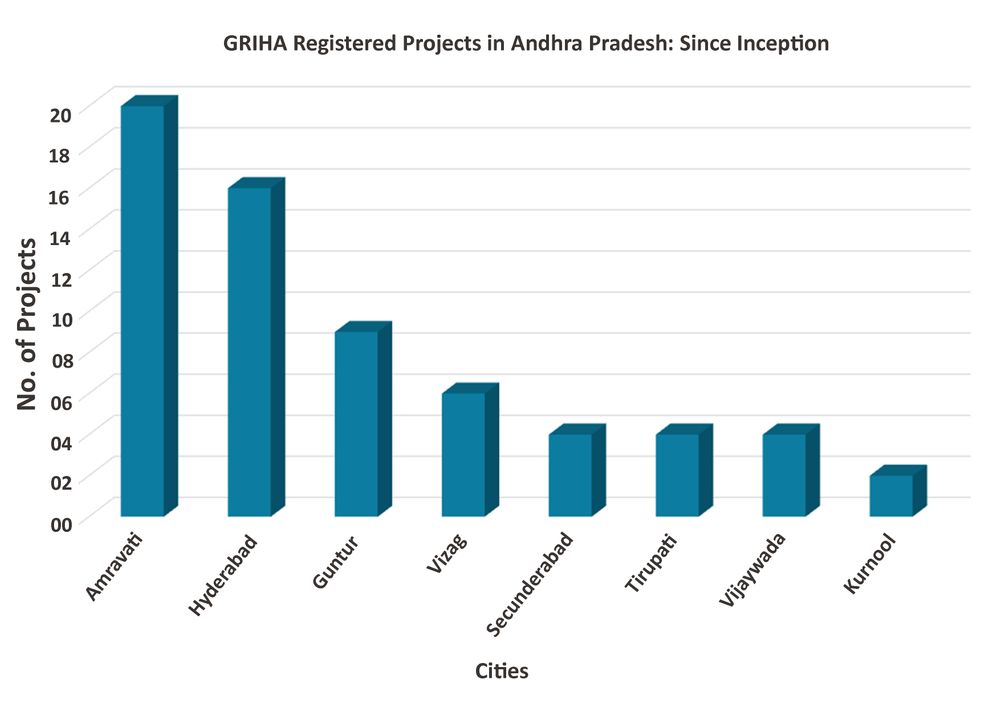
GRIHA has certified 65 green projects in the state. (GRIHA Certified projects: Since Inception), with the highest in Amravati (20 projects), followed by Hyderabad (16 projects). This features two cities Amravati and Hyderabad, which did not appear to make a mark in the graphs for LEED and IGBC.
As Amravati is the legislative capital of Andhra Pradesh, most of the buildings here are government buildings or government-owned. They can truly set a great example for their cities to focus on green and sustainable urban development.
EV infrastructure in Green Buildings
Green Building Rating systems prevalent in India are already advocating the allocation of preferred parking spaces for E-vehicles along with charging outlets. Conducive and popular EV policies have also been formulated with investment-attractive opportunities such as for Delhi, Telangana, Andhra Pradesh, Gujarat and Uttar Pradesh. However, there is a requirement for greater consumer participation in ramping up EV adoption and even infrastructural overhauls.
Investments in the EV market will rise through strong drivers to rapidly scale-up charging infrastructure. It is vital to achieve India’s national goals on electric mobility, air quality and climate change. This will be made possible if industries like ASSOCHAM and CII participate in the cause and mandate EV codes for buildings. Revised ECBC guidelines with inclusion for optimised energy use, off-grid/on-grid renewable energy sources and clean energy alternatives should also be provided to green projects to consider.
How is e-mobility transforming our urban infrastructural requirements?
According to a 2016 study, with the development of electric mobility in developed countries such as Australia, 33990 jobs are currently created and 3.1 billion euro will be generated as value added by 2030. Despite that structural change in the transport sector is a major challenge in terms of a triple bottom line in India. As per the National Electric Mobility Mission Plan (NEMMP) 2020, there are four major barriers in the adoption of the electric vehicles, which are:
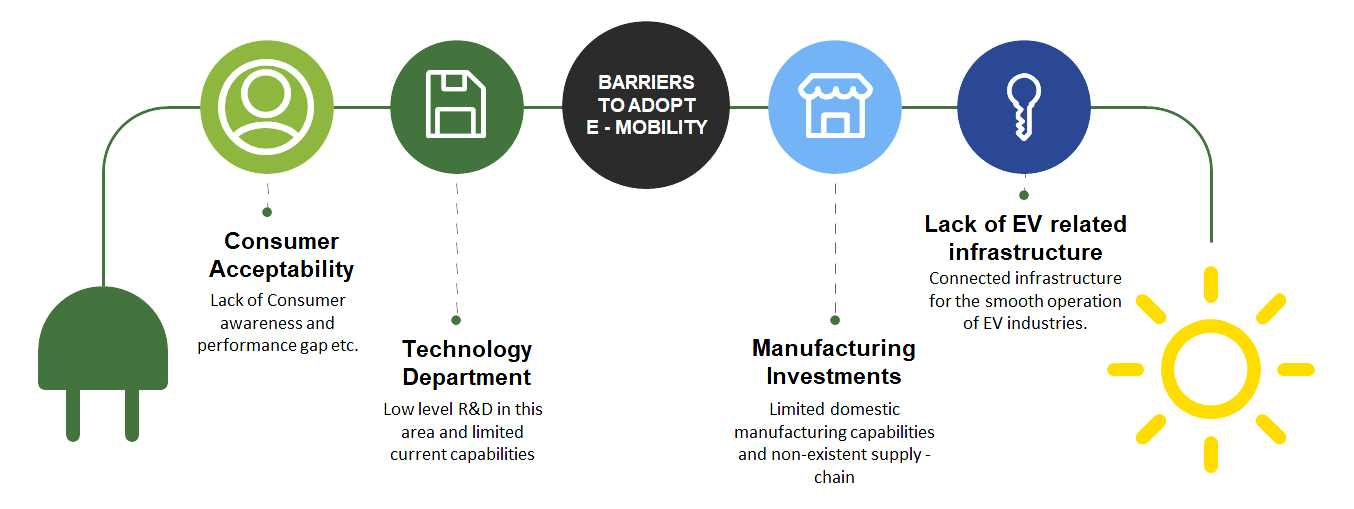
To overcome these barriers, creating a market for electric vehicles through greater consumer acceptance should include consideration of issues related to the increase in the purchase price and various other demand-generating measures. As of now the governmental support through subsidy, tax rebates, individual incentives, deduction in the road taxes and saving of cost from increasing fossil fuels prices are some of the other reasons that have gained the attention of the manufacturers and citizens in India.
Although the authorities encourage the adoption of EVs on one hand, there are other attributes where the Government loses its revenue. Sudden acceptance of EV’s will force the existing automobile industries to dispose of major electronic components used for ICE vehicles, loss of revenue through selling of fuels, downfall of tie ups with companies that manufacture fuel based vehicles, etc.
To mitigate this squandering, the Government of India and Ministry of Heavy Industries and Public Enterprises approved the Production Linked incentives (PLI) scheme for the ‘National Programme on Advanced Chemistry Cell (ACC) battery storage’. This helps in establishing a supply chain for lithium batteries all over India, making it a self-sustainable Hub and reducing dependency on China for major electric vehicle components. This will help in localization of cells and batteries, bringing down the cost of electric vehicles, exporting of EV components to other countries and development of employment.


India has initiated the road maps for policies development for Electric Vehicles from various ministries with respect to incentives and tax rebates, such as:
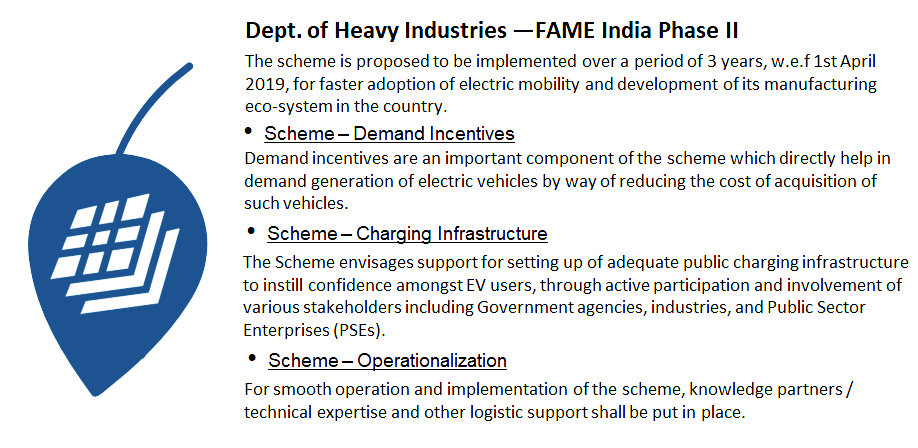
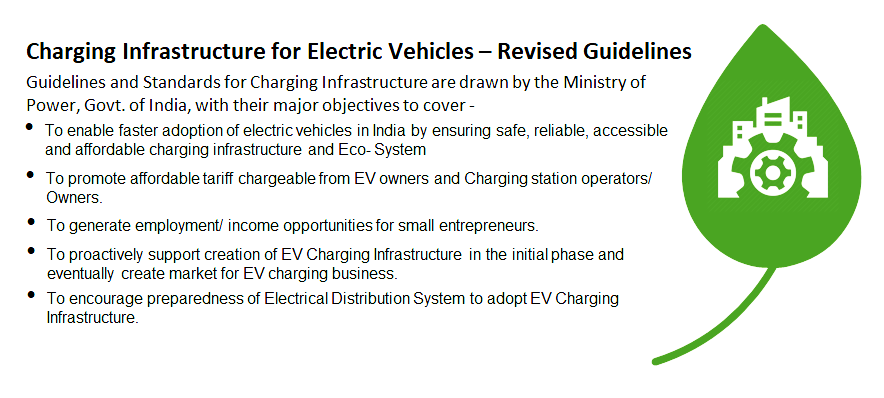

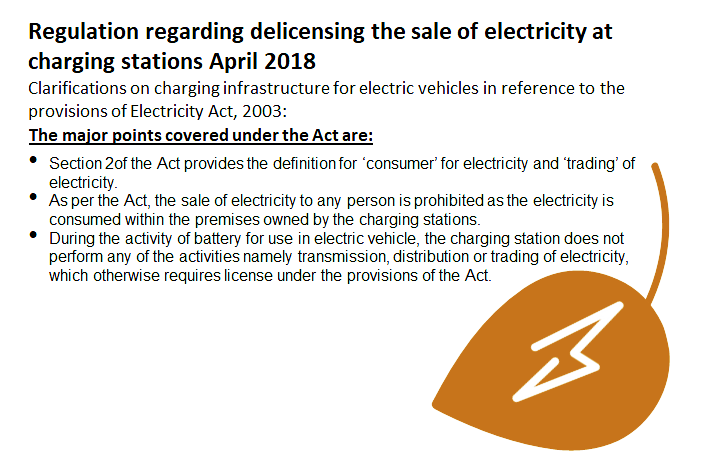
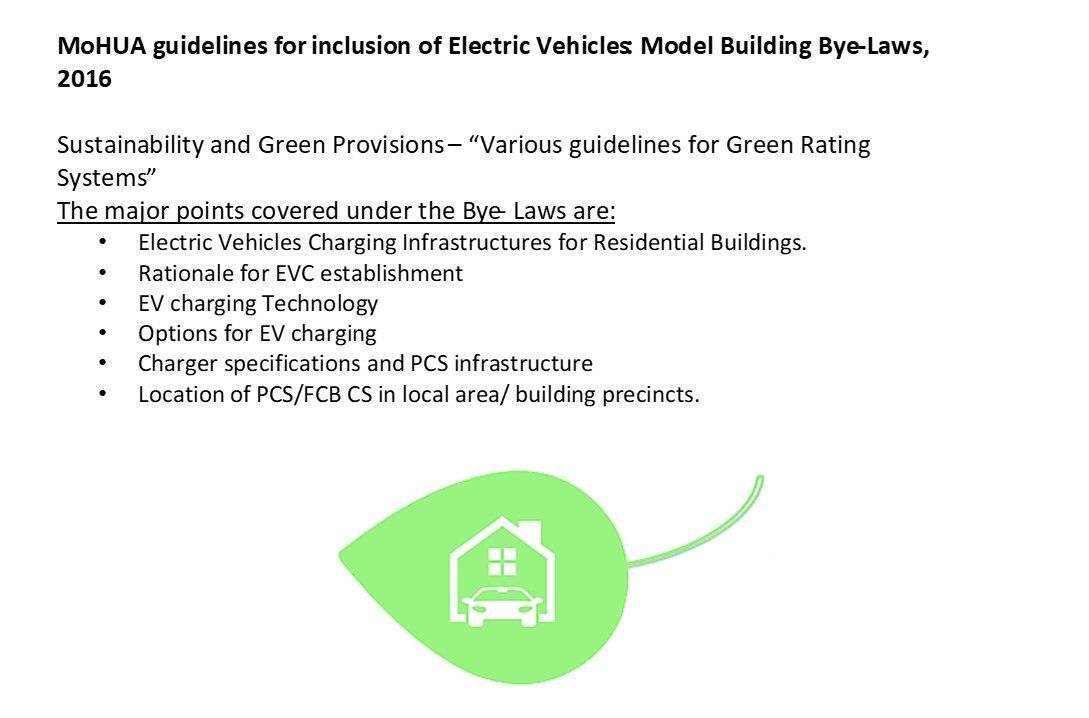
Analysing the overall policies and Bye –Laws shows a promising sign in value addition within 5 years of the date of commencement of the projects, capturing nearly 60% of the Indian automobile markets. 570 billion rupees allocated to the PLI scheme will provide the impetus needed for manufacturing industries and value added by private entities. Whereas the other schemes such as FAME Phase II, MOHUA Model Building Bye- laws and few other policies will make manufacturers globally competitive, boost exports, achieve economies of scale and produce cutting edge products.
Gender Equality and Sustainable Mobility
Proper planning of mobility and transport policies is essential to ensure equality among genders. It is known that there are significant differences between the mobility patterns for various different types of road users, the mobility of marginalised people are highly concentrated around the house as compared to men's extensive mobility. The socially excluded people are highly dependent on the people who are financially stable leaving the vulnerable marginalised people helpless. These marginalised people include women, children, differently abled, the elderly, scheduled tribes, scheduled castes and sexual minorities in India.
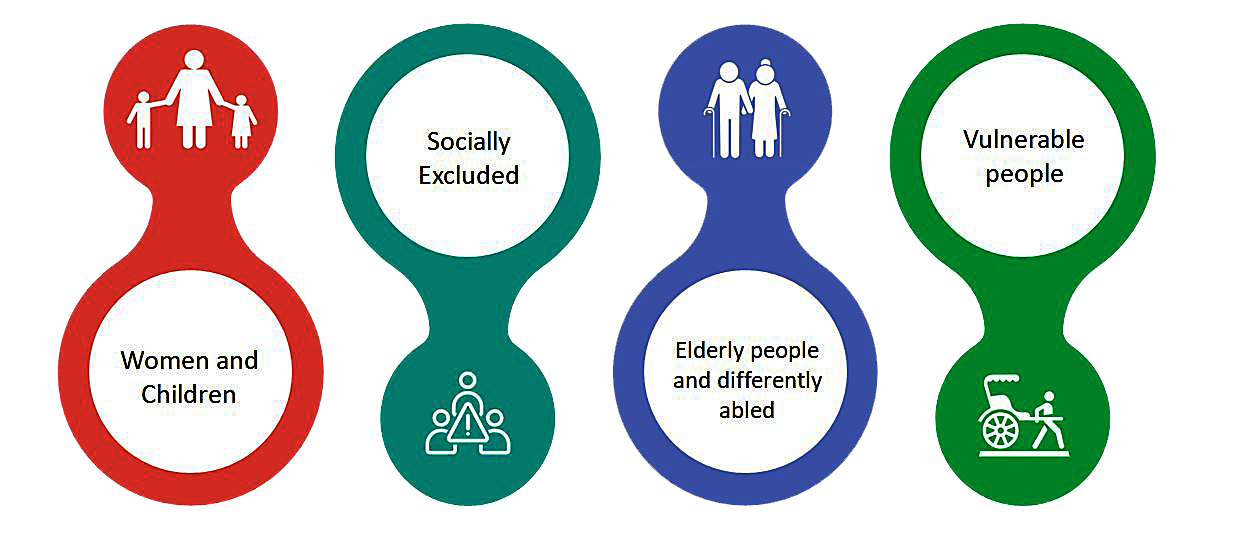
Surge in Employment - EV manufacturing process is much less complicated (due to less number of parts as compared to ICE) and highly automated, making the participation of women and disabled in the workforce quite feasible. Employment generation will benefit the upliftment of poorer segment of the society. These tasks are no longer gender-oriented and ease in the understanding of various mechanical components making it accessible for inclusion of workforce diversity. However, gender-specific requirements, for designing a car and the ease/comfort it offers to various user-segments, must be considered in every stage of design.
Ease of mobility – The mechanical parts used in vehicles such as gears and clutches are complex to coordinate for the social minorities. In the absence of such components, the driving process becomes a lot easier compared to ICE vehicles, encouraging the adoption of electric vehicles between diverse communities. Such an initiation builds up confidence and reduces the dependence on others.
Other strategies to mitigate gender inequalities are stated below -

Integrating EV charging facilities in the existing residential set-up: RWA's Role redefined
In the year 2020, BSES Rajdhani Power Limited conducted an open survey to know the preference of the EV users in meeting the charging facilities for the Electric Vehicles. In the responses, it stated that home-based charging was the first preference adopted by the majority. A few also suggested that they should use charging allocations for offices and shopping malls. On duration of charging, as expected most users indicated their preference to charge their vehicle at night through the early morning hours as needed.
The Resident Welfare Association (RWA) plays an important role when it comes to allocating charging facilities on Society's premises. Though there are no hard and steady rules and regulations regarding the integration of Charging facilities for EV, many of the RWAs prefer to have their own set of rules and regulations that covers their requirements. According to the study conducted in Delhi, RWAs are ready to integrate charging facilities under the following terms:
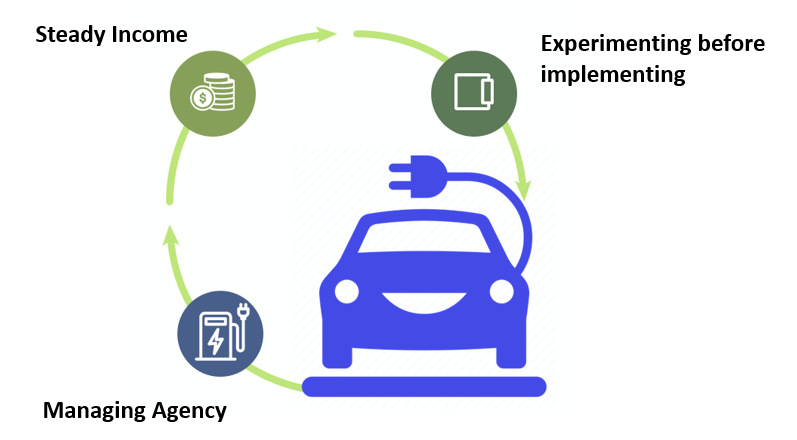
GreenTree Global is extensively conducting research on this concept. The team has proposed to work in this segment and develop a set of green guidelines for residents at the end of it. Interested participants may reach out to our research wing [email protected] with their EOI for collaborative study in this domain.
UK PACT: Electrifying Urban Mobility in Kakinada
Of the 100 Smart Cities of India, Kakinada in Andhra Pradesh, has emerged to be a forerunner in the country with its conducive policy framework and forward-looking approach towards ICT (Information, Communication and Technology) in engaging with their citizens. The E-Mobility Policy of Andhra Pradesh 2018-2023 plays an instrumental role in turning the state into an investor's paradise. The policies are inclusive in terms of inviting participation from all primary beneficiaries and specific stakeholders who could be key economy drivers in the E-mobility sector of the state. It also puts emphasis on skill development and capacity building of all EV enthusiasts, right from entrepreneurs to students. Some salient features of the policy constitute:
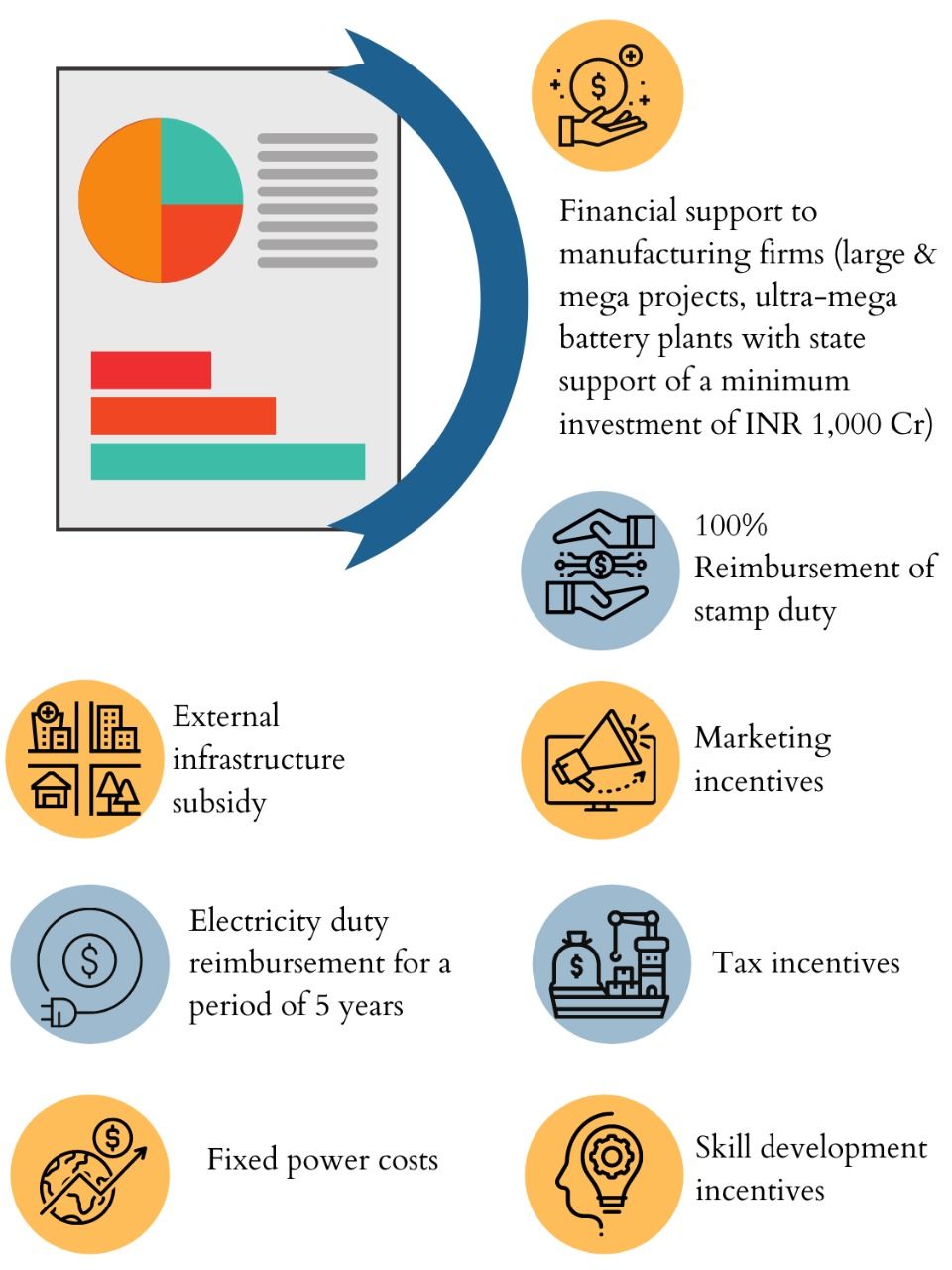
Inspired by the city's forward-looking plans, the consortium comprising of Research Triangle Institute, India (Lead), Urban Mass Transit Company (UMTC) and GreenTree Global are working towards Theme 2: Electrifying Urban Mobility by UK PACT (Partnering for Accelerated Transitions) in the pilot city Kakinada.
The programme is aimed at mainstreaming electric mobility in Kakinada, Andhra Pradesh by institutionalising capability and capacity building of primary beneficiaries and stakeholders in the city. Some identified beneficiaries include groups like: government bodies, public/private entities, economy drivers, development communities, professionals and all the citizens of Kakinada. This programme will aid the efforts of the Kakinada Municipal Corporation (KMC) and Kakinada Smart City Corporation Limited (KSCCL), Andhra Pradesh by:
- fast-tracking uptake of electric vehicles for public transportation through schemes and policies
- analysing future mobility patterns and the issue of air quality,
- development of sustainable business models,
- green procurement strategies,
- stakeholder consultations and capacity building sessions.
Finally, the vision of the programme is to encourage holistic, economic and sustainable development of all sections of society, with regards to e-mobility, climate change mitigation strategies and social revival.
Our long-term vision is to replicate the programme's success and translate it onto other willing participating cities. If the programme's description and envisioned objectives interest you, kindly reach out to us on [email protected] and we may together explore opportunities of devising a similar project for your city. We would appreciate it more if existing relations with the urban local bodies of your city could be leveraged to tap into the underlying potential of your city, with regards to the programme's objectives.
GreenTree Global will be conducting specialising training and awareness building programs in a mixture of virtual/physical set-up for all. Our target audience:
- Students from ITI, technical colleges and universities
- Budding entrepreneurs and businesspersons
- Auto Industry and service sector employees, etc.
Watch this space for updates on training agenda, speakers' profiles and registration links!
In Conversation with Mr. N Mohan and Mr. Pradeep Kumar - Transforming the e-Mobility Landscape of India
The team at GreenTree Global had the pleasant opportunity to interview Mr. N Mohan, Deputy General Manager at Convergence Energy Services Limited. An experienced professional with over 15 years of experience in energy sector, he is
presently leading an assignment of E-Mobility and Charging Infrastructure to develop a network of Public Electric Vehicle Charging Stations to enable faster adoption of EVs in India. In our conversation, we spoke about EESL, which is driving the e-mobility movement forward by procuring EVs to be deployed in government offices and setting- up charging stations. We also spoke about additional infrastructural requirements which may need to be developed by the government and public-private entities jointly. Watch our interesting conversation here!
Video - yet to be downloaded & uploaded
In-house Expert Comments
The team firmly believes that prepping our buildings for an EV-ready future is the need of the hour. As sustainability organisation are also participative in this segment with more gusto today than ever, us energy consultants must consider all aspects of e-mobility and allied industries. Especially in the buildings segment, dependence on the existing infrastructure must extend to accommodate the future integration of EV charging setup. Here is a 4-point orientation which building energy experts can begin working on in close aid with the government, industries and power infrastructure mechanisms.

What’s Next?
- Integrated Urban and Electrical reforms
- Light House Project (LHP) technologies
- Urban Heat Island Effect - Sustainable Planning
- Integrated City level Green Certifications
What have you missed?
- Sustainable Cooling for Thermal Comfort
- Green Jobs: A Perspective from the Green Buildings Market
- Introducing First Green Building Newsletter of India
Note: The team has sourced data through various rating agencies and desk research. Collaboration with other rating agencies are in progress to make the information comprehensive. The team works tirelessly to put forth green building development news for our readers. Please give us due credit before re-creating our work. We would appreciate collaborations and joint-efforts, if floated our way. For any query, please contact: [email protected]
GreenLetter (GLJUN21) Team




